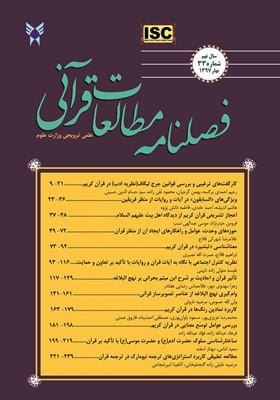مطالعه تطبیقی کاربرد استراتژیهای ترجمه نیومارک در ترجمه قرآن
محورهای موضوعی : فصلنامه مطالعات قرآنیمرضیه خلیلی زاده گنجعلیخانی 1 , آناهیتا امیرشجاعی 2
1 - مربی، مترجمی زبان انگلیسی، عضو هیأت علمی مجتمع آموزش عالی بم
2 - مربی، مترجمی زبان انگلیسی، عضو هیأت علمی مجتمع آموزش عالی بم
کلید واژه:
چکیده مقاله :
قرآن در مقام نخست و بسیار فراتر از عالیترین آثار کلاسیک عربی است. یک شاهکار ادبی از حس بینظیر. اگرچه طی قرون اخیر سیر صعودی ترجمه قرآن کریم به زبان انگلیسی از جهات کمی و کیفی را شاهد بودهایم، اما از آنجائی که ترجمهها صرفاً به نثر بوده و نیز با محدودیتهای خاص آن زبان طبعاً قادر به انعکاس جنبه هنری ادبی و شکوه فصاحت و بلاغت خاص قرآن مجیدی که بین شعر و نثر واقع شده نگردیدهاند. ترجمه قرآن کریم همواره موضوع چالش برانگیزی از ابتدای پیدایش آن تا کنون بوده است. مطالعه حاضر به مقایسه سه ترجمه موجود از سه سوره قرآن(اخلاص، ناس، فلق) با ترجمه محمد علی حبیب شاکر، عبدالله یوسف علی و پیکتال به منظور بررسی استراتژیهای ترجمه بر اساس طبقه بندی پیتر نیومارک(1981) پرداخته است تا بیشترین استراتژی یا استراتژیهای بکاررفته در امر ترجمه و موفقترین آنها در انتقال معنا و مفهوم صحیح و درست کلام مقدس الهی مشخص گردد.
Quran is the first and even the best Arabic classic work. A literary masterpiece full of unique sense. Although the qualitative and quantitative progress of Quran translation could be seen during recent centuries, since the translations were all in prose and with special limitations of the target language, the translations weren't good mirrors to reflect Quran's eloquence and fluency. The present paper compares three existing translations (Ikhlas, Naas, and Falaq) by Muhammad Ali Habib Shakir, Abdullah Yusuf Ali and Muhammad Marmaduke Pickthall in order to study the translation strategies based on Newmark's classification. The aim is to find the most frequent strategy (s) in translation and the most successful one (s) in transferring the correct meaning and concept.
کتب انگلیسی
Abdul-Raof, H. (2001). Quran Translation. Richmond Surrey: Curzon Press.
Manafi Anari, S. (2005). An Approach to English Translation of Islamic Texts. (6th ed). Tehran: SAMT.
Munday, J. (2001). Introducing Translation Studies, Theories and Application. London and New York: Routledge.
Newmark, P. (1981). A Textbook of Translation. New York and London: prentice. Hall
Newmark, P. (1988). Approaches to Translation. London: Prentice Hall International.
Nida, E. A & C. A. Taber. (1969). Theory & Practice of Translation. Netherlands.
Yuksel, Yuksel et al. (2007). Quran: A Reformist Translation. USA: Brainbow Press.
کتب فارسی
انوشیروانی، علیرضا. 1382ش، «ترجمه انگلیسی قرآن کریم»، مجله مطالعات ترجمه، شماره 2.
_||_
Abdul-Raof, H. (2001). Quran Translation. Richmond Surrey: Curzon Press.
Manafi Anari, S. (2005). An Approach to English Translation of Islamic Texts. (6th ed). Tehran: SAMT.
Munday, J. (2001). Introducing Translation Studies, Theories and Application. London and New York: Routledge.
Newmark, P. (1981). A Textbook of Translation. New York and London: prentice. Hall
Newmark, P. (1988). Approaches to Translation. London: Prentice Hall International.
Nida, E. A & C. A. Taber. (1969). Theory & Practice of Translation. Netherlands.
Yuksel, Yuksel et al. (2007). Quran: A Reformist Translation. USA: Brainbow Press.

